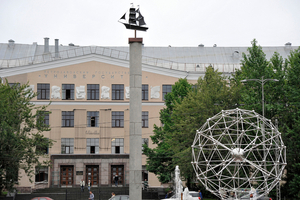PetrSU is studying the effectiveness of “green technologies” in housing construction in the Arctic
Scientists from PetrSU and Murmansk State Technical University, within the framework of the international project KO 1089 “Green construction in the Arctic region” under the Kolarctic Cross-Border Cooperation Program, have developed a laboratory model for testing “green technologies” and assessing the effectiveness of their work in the northern territories.
Such a laboratory has already been erected on the territory of the Botanical Garden of PetrSU, on the territory of the Murmansk region the construction of the laboratory is being completed.
The laboratory is a one-storey building 12x6m, made using modern technologies of wooden housing construction, equipped with energy efficient engineering equipment, as well as a special monitoring system for research. A system of sensors is installed in the walls, which allows you to monitor temperature and humidity indicators, in particular, to assess the loss of thermal energy.
The experimental facilities (laboratories) erected within the framework of the project will be used in studies of the effectiveness of various options for enclosing structures (various options for thermal insulation materials, a “green” roof) and engineering systems (heating, ventilation), alternative energy sources, as well as “smart home” systems. In addition, the model laboratory will be used in the educational process and research work of PetrSU students,
– notes the project manager at PetrSU, Associate Professor of the Department of Technology and Organization of Construction, Candidate of Economic Sciences Alexander Kuzmenkov.
Wood was used as the main structural material for the walls. this material is an environmentally friendly and renewable resource.
In shape, the laboratory building consists of two volumes connected by a vestibule. Symmetrical parts of the building are made using two different technologies: one part – using frame technology, the other – using double frame technology. The traditional technology of making walls from logs in the form of a single frame in the modern conditions of the North cannot be used due to the low thermal insulation properties of the structure. The use of two technologies at once is also explained by the fact that the double logging technology cannot be massively applied on the territory of the Murmansk region due to the limited resource base.
The cavity between the logs of the north-facing wall is divided into 3 parts. One part is filled with linen mats, the second with wood chips, and the third is left unfilled. The north wall of the frame is also divided into three sections. One part is insulated with linen mats, the middle part is insulated with ecowool by spraying, and the third part is insulated with mats with a scum (material based on dried algae). This solution will allow evaluating the effectiveness of various heaters in the structures under consideration and in different climatic conditions.
Various options were considered for heating the facility. The instability of weather temperatures, the absence of water bodies on the territory does not allow the use of heat pump installations, electric floor heating can lead to wood drying and deformation, mounting XL-Pipe in a cement-sand screed is an inexpedient solution for a wooden house, and low-temperature electric infrared panels are advisable to use for zonal heating of the room. The most optimal way of uniform and fast heating is electric convectors, which were chosen for installation. The selected convectors are equipped with a Wi-Fi control module, which allows you to change the heating parameters even from an ordinary smartphone.
Supply and exhaust ventilation with recuperation was chosen as the main ventilation system to improve the energy efficiency class of the building, which provides the house with fresh air without the penetration of cold streams. For a comparative study, the possibility of arranging an alternative natural ventilation system, which is more relevant for the log part of the building, is being considered.
The project is carried out by PetrSU in cooperation with MSTU, University of Oulu (Finland), University of Tromsø (Norway) and Umeå University (Sweden).

